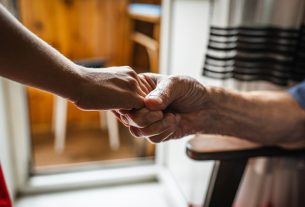Every responsible parent knows that small children need to be supervised around pools. Staying in it alone is a real danger, but it turns out that disaster can still strike. Nikki Jurkotz, a paramedic and first aid educator at Tiny Hearts, said that drowning is the main cause of death for children between the ages of one and four.
According to Jurkotz, knowing that there are others in the pool area is insufficient in regards to monitoring small children when swimming. She added that there are 3 words that can prevent the risk of drowning of toddlers in the pool (or in the sea).
“This video was sent by one of my followers. She is a children’s nurse by profession and this is her little boy,” Niki presented in a TikTok video . In the video, a toddler is seen crouching on the edge of the home swimming pool. No one else is in the frame – until a small dog walks by and knocks the toddler into the pool.
“Just because there are a lot of adults around, it doesn’t mean active supervision is happening,” Nikki says. The toddler almost drowned in the pool even though there are adults nearby.
She added that “The toddler’s mother was inside the house and there were three adults by the pool, but they were not actively supervising the child.” When the toddler falls into the water, someone is heard screaming and alerting the adults that the child has fallen into the pool. A few seconds later three adults are seen running towards the toddler when one of them jumps into the water and pulls him out.
@tinyheartseducation ⚠️TW: child falling into pool. The leading cause of death in children 1-4 years old? Drownings. Use this verbal confirmation of “I’m on watch” every time the responsibility of your child is transferred to someone new. This ensures there is safe and active supervision of your child. Remember these other tips: if your child is missing, check the water first always have active supervision around water learn cpr so you can perform it on your child if it is ever needed Our online first aid course for USA parents will be launching Wednesday 29th of March. Click the link in bio to join the waitlist #drowningprevention #poolsafety #firstaid ♬ original sound – Tiny Hearts
This story ended in a miracle, but it could have ended completely differently.
“In my job as a paramedic, I’ve heard so many people say, ‘I thought someone else was watching the child,'” Nikki explains. Nikki’s method of solving the problem is to announce who is responsible for the children at that moment. “When a pilot takes control of a plane, he says ‘I have control’ or ‘my plane.’ ‘ to confirm who is in charge.”
Comments reflect similar experiences by viewers
“I almost drowned as a three-year-old girl in a family pool at Christmas with a lot of people standing there. Being present is not equivalent to watching,” one comment said.
Others noted that even though no one was right next to the pool, they reached the toddler within seconds. “The lady responded right away so I’d say she was actively watching,” one wrote but others disagreed. “They got to him within five seconds. I had to count because even to me it felt like a long time to see that little baby struggling in the water,” one wrote.
Another added, “If she was actively monitoring he would never have had to go so close to the edge of the pool,” said another.
Several people admitted that they had used the transfer of responsibility strategy with their children in the past. “It’s something we’ve always done with our children, now with our grandchildren. We call the person and wait for them to respond back: ‘I’m with him’ and then we can let go,” wrote one.
Another added, “It’s a rule for me that a supervising adult is always at arm’s length, especially around to a water reservoir. I get eye rolls when I demand it, but I know it’s the safest.” Another concluded, “My parents and family members had a whistle that the responsible adult wore around his neck. They would switch between them and each would take their time.”
Preparations for water safety for young children
According to medical institutions worldwide such as the Seattle Children’s Hospital, it is crucial to watch young ones near any body of water. They can drown in as little as two inches of water, according to the institution.
There are key tips recommended by Seattle Children’s Hospital to help keep children under the age of five safest around water, that are important to follow for their safety.
- Have a lifejacket on your child when near a body of water.
- Individual floaties, rafts, and “wings” on your child are not enough to ensure your child’s safety in the water.
- Teach your child to wait for your “OK” before getting into the water.
- Be sure to choose areas with lifeguards for swimming and playing. Having a lifeguard present still requires you t watch closely, with extra back-up.
- If with other responsible adults, take turns as “water watchers,” to make sure eyes are always on the child near the body of water.




